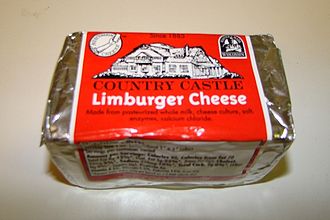Limburger



Limburger is a type of cheese that originated in the historical Duchy of Limburg, which is now divided among three countries: Belgium, Germany, and the Netherlands. Limburger is especially known for its strong smell, which has been compared to that of feet or body odor. This distinctive aroma is a result of the cheese maturing process, during which beneficial bacteria are applied to the surface of the cheese. Despite its pungent odor, Limburger has a somewhat milder taste, with a creamy and slightly grassy flavor.
History[edit]
The production of Limburger cheese dates back to the 19th century in the Duchy of Limburg. The cheese was originally created by Belgian monks as a source of nutrition. Over time, its production spread to other regions, including the United States, where it became particularly popular among German immigrants.
Production[edit]
Limburger cheese is made from cow's milk. The milk is pasteurized, and then bacteria cultures are added to start the fermentation process. The cheese is then formed into blocks and salted. The most distinctive aspect of Limburger cheese production is the washing of the cheese's rind. During the aging process, which can last from three to six months, the cheese is regularly washed in a brine solution. This process encourages the growth of certain bacteria, including Brevibacterium linens, which is responsible for the cheese's strong smell.
Characteristics[edit]
Limburger cheese is soft with a creamy texture. It has a pale yellow color on the inside with a reddish-brown rind. The cheese's flavor is surprisingly mild compared to its strong odor, with a slightly tangy and spicy taste that becomes stronger and more pungent with age.
Culinary Uses[edit]
Despite its reputation, Limburger cheese is a versatile ingredient in the kitchen. It is often eaten on rye bread with onion slices, a traditional way to serve it in Germany and the Netherlands. Limburger can also be melted into dishes, where its flavor becomes less intense and more palatable to those unaccustomed to its strong aroma.
Cultural Impact[edit]
Limburger cheese has made its mark not only in culinary circles but also in popular culture, often used as a symbol of strong odors in cartoons and comedy sketches. Its distinctive smell has made it a subject of curiosity and, sometimes, derision, but it remains a beloved delicacy among cheese aficionados.
See Also[edit]
Ad. Transform your life with W8MD's Budget GLP-1 injections from $75


W8MD offers a medical weight loss program to lose weight in Philadelphia. Our physician-supervised medical weight loss provides:
- Weight loss injections in NYC (generic and brand names):
- Zepbound / Mounjaro, Wegovy / Ozempic, Saxenda
- Most insurances accepted or discounted self-pay rates. We will obtain insurance prior authorizations if needed.
- Generic GLP1 weight loss injections from $75 for the starting dose.
- Also offer prescription weight loss medications including Phentermine, Qsymia, Diethylpropion, Contrave etc.
NYC weight loss doctor appointmentsNYC weight loss doctor appointments
Start your NYC weight loss journey today at our NYC medical weight loss and Philadelphia medical weight loss clinics.
- Call 718-946-5500 to lose weight in NYC or for medical weight loss in Philadelphia 215-676-2334.
- Tags:NYC medical weight loss, Philadelphia lose weight Zepbound NYC, Budget GLP1 weight loss injections, Wegovy Philadelphia, Wegovy NYC, Philadelphia medical weight loss, Brookly weight loss and Wegovy NYC
|
WikiMD's Wellness Encyclopedia |
| Let Food Be Thy Medicine Medicine Thy Food - Hippocrates |
Medical Disclaimer: WikiMD is not a substitute for professional medical advice. The information on WikiMD is provided as an information resource only, may be incorrect, outdated or misleading, and is not to be used or relied on for any diagnostic or treatment purposes. Please consult your health care provider before making any healthcare decisions or for guidance about a specific medical condition. WikiMD expressly disclaims responsibility, and shall have no liability, for any damages, loss, injury, or liability whatsoever suffered as a result of your reliance on the information contained in this site. By visiting this site you agree to the foregoing terms and conditions, which may from time to time be changed or supplemented by WikiMD. If you do not agree to the foregoing terms and conditions, you should not enter or use this site. See full disclaimer.
Credits:Most images are courtesy of Wikimedia commons, and templates, categories Wikipedia, licensed under CC BY SA or similar.
Translate this page: - East Asian
中文,
日本,
한국어,
South Asian
हिन्दी,
தமிழ்,
తెలుగు,
Urdu,
ಕನ್ನಡ,
Southeast Asian
Indonesian,
Vietnamese,
Thai,
မြန်မာဘာသာ,
বাংলা
European
español,
Deutsch,
français,
Greek,
português do Brasil,
polski,
română,
русский,
Nederlands,
norsk,
svenska,
suomi,
Italian
Middle Eastern & African
عربى,
Turkish,
Persian,
Hebrew,
Afrikaans,
isiZulu,
Kiswahili,
Other
Bulgarian,
Hungarian,
Czech,
Swedish,
മലയാളം,
मराठी,
ਪੰਜਾਬੀ,
ગુજરાતી,
Portuguese,
Ukrainian